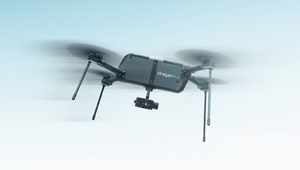Dual-Robot Surgery Performed in Texas; World’s FirstDual-Robot Surgery Performed in Texas; World’s First
University of Texas Southwestern Medical Center doctor used robotic platforms from different manufacturers

A surgeon at the University of Texas Southwestern Medical Center performed the first-ever surgery using two separate robotic surgery robots, according to one of the robots’ developers, Levita Magnetic.
Jeffrey Cadeddu, a urologist and professor at UT Southwestern, used Levita’s Mars surgical platform alongside Intuitive Surgical’s Da Vinci SP single-port robot to successfully remove a patient’s prostate gland.
Cadeddu used Mars’ magnetic-positioning system to maneuver internal organs, which allowed for the precise retraction of tissue to remove the prostate without damaging adjacent neurovascular bundles responsible for erectile function and urinary continence. The Da Vinci robot was able to successfully complete the single-port, or single-incision, procedure.
“This marks the first time two different systems have been used together in a single robotic procedure, and it highlights the versatility of Levita’s Mars platform,” Cadeddu said. “The magnetic component of Mars added significant value by improving precision and enabling improved access to key areas of the pelvis.”
The heart of Mars is a pair of magnets, one of which is attached to a clip that grasps an internal organ or tissue and one of which is at the end of a robotic arm outside the body. By moving the arm, the surgeon can manipulate the internal magnet and move or retract the internal organ without the need for an incision. A second arm with an endoscopic camera is inserted into the area to provide a visual of the procedure.
According to Levita, dual-platform surgery provides a glimpse into the future of robotic-assisted surgery, in which multiple systems complement one another to provide successful outcomes. It also highlights the potential of robotic collaboration by incorporating the unique capabilities of different systems into a single operation.
In this case, the Da Vinci robot excels in single-incision procedures, while the Mars system is ideal for maneuvering internal organs without incision, an “ideal pairing,” Levita said.
“This procedure demonstrated that the Mars platform is both an independent surgical solution and also a powerful enhancement to traditional console-based robotic systems,” Levita founder and CEO Alberto Rodriguez-Navarro said. “By combining technologies, we’re creating a new standard for surgery that prioritizes patient safety, efficiency and better outcomes.”
“This procedure marks the beginning of multiple-robot cooperation and integration into the operating room,” added Vipul Patel, a pioneer in robotic urological surgery and the medical director of AdventHealth’s Global Robotics Institute. “Two different systems working together in harmony to provide the optimal service to the surgeon and patient.”
About the Author
You May Also Like


.jpg?width=700&auto=webp&quality=80&disable=upscale)
.jpg?width=700&auto=webp&quality=80&disable=upscale)

.jpg?width=300&auto=webp&quality=80&disable=upscale)


